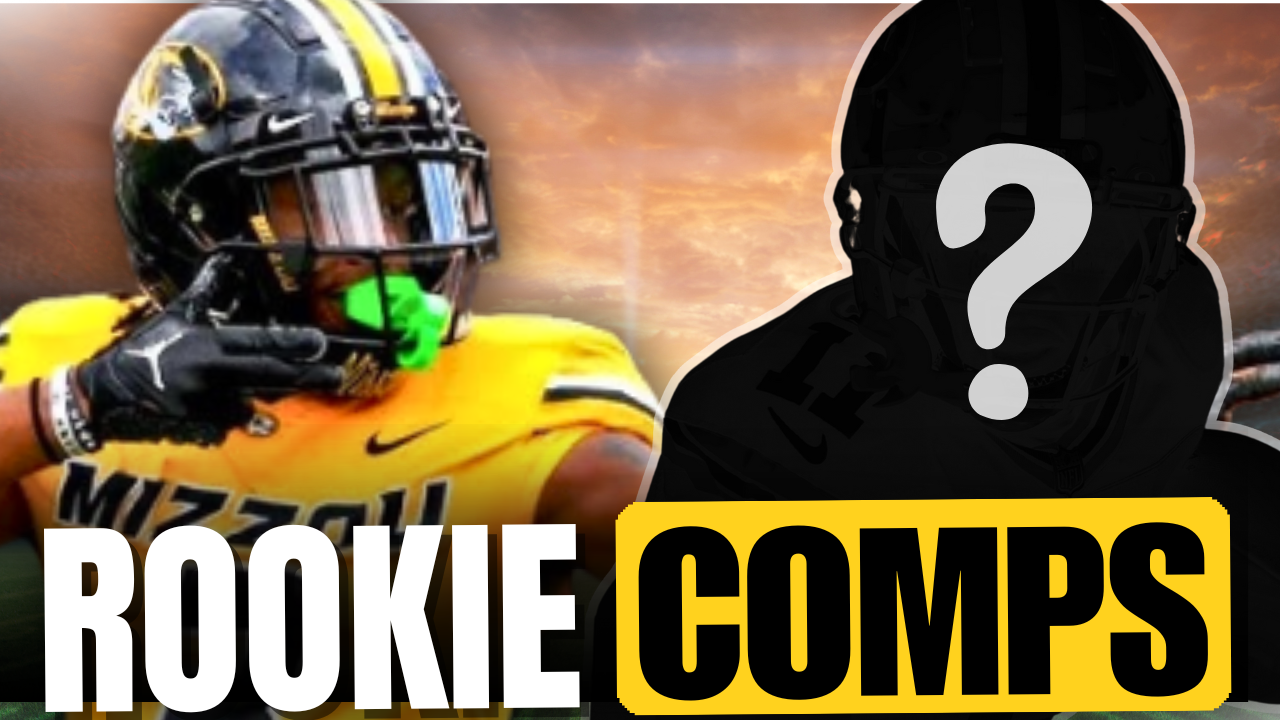
NFL Comps: 2025 Rookie Wide Receivers
Best NFL Comps For the Top 2025 Rookie Wide Receivers
‘Tis the season for NFL Comps! Love them or hate them, NFL comparisons are a big part of rookie season. I don’t know if there’s really much to gain from them other than just the fun of it, but I love comps and you love comps, so here we are: the best NFL comps for the top rookie wide receivers in the 2025 draft class.
Tetairoa McMillan, Arizona
Tet McMillan is a prototypical alpha X-receiver. he wins with size and physicality but also has surprising lateral agility and quickness for a player of his size. He’s a fluid route runner who can line up anywhere in the formation and can run the entire route tree. McMillan does an excellent job of tracking the ball in the air while utilizing his size to box out defenders and meet the ball at its highest point. He has excellent body control and field awareness with the strong hands to win in traffic, along the sideline, or in contested situations.
McMillan projects as a team’s No. 1 option who will command volume. Offenses will utilize his versatility to create mismatches both on the outside and as a big slot. He will dominate in the red zone and be a guy his quarterback can rely on in any situation.
NFL COMP: DRAKE LONDON
Like McMillan, Drake London is a big physical outside WR who also thrives from the slot. He’s great at the catch point and can add value after the catch. London was OK in his first two seasons, but improved quarterback play really helped him breakout in 2024. He had 158 targets, 100 receptions, 1,271 yards, and 9 TDs.
Hopefully Tet McMillan will land with a good quarterback from day one and he can avoid the slow start to his career like London had. He will have a similar impact as a true alpha wide receiver if that happens. He won’t reach that Justin Jefferson/Ja’Marr Chase/CeeDee Lamb level, but he can be a mid-tier WR1 in the NFL and a top-15 WR for us in fantasy football.
Emeka Egbuka, Ohio State
Emeka Egbuka is a physical slot receiver whose game should translate well to a productive role in the NFL. He’s a detailed route runner who is smooth getting in and out of his breaks. He creates easy separation with incredible quickness, lateral agility, and change-of-direction. Egbuka tracks the ball well in the air and has reliable hands to make plays for his quarterback. The play isn’t over once he has the ball in his hands. Egbuka is excellent at creating additional yardage after the catch.
He’ll be a primary slot guy in the NFL. He has no hesitation to work over the middle of the field and take the hits that come along with it. He’s very comfortable in traffic and can run the full route tree from the slot.
NFL offenses will utilize him as a reliable chain-mover. They’ll set up Egbuka to catch the ball underneath and turn up field and become that YAC monster. He won’t be much of a deep threat, but Egbuka will thrive in the short and intermediate areas. He will be where his quarterback needs him to be, when he needs him to be there. That’s a valuable asset to almost any offense in today’s NFL.
NFL COMP: ROBERT WOODS
Prime Robert Woods was an exciting player who meshed perfectly in the Sean McVay offense as a go-to target for a young Jared Goff. He was versatile enough to move around the formation and line up at different positions. He was sneaky good after the catch as well. Woods was that same reliable go-to target in must-have situations like Egbuka was at Ohio State. They have similar size, similar body type, and do a lot of the same things on the field. They really work that short/intermediate area at a high level.
Woods had three-straight 130 target seasons plus back-to-back 90-catch seasons (another with 86). He had 1,200 receiving yards in 2018 and 1,100 in 2019.
That’s the type of production we can expect from Emeka Egbuka. He’ll be perfect in an offense that plays a lot of 11-personnel and is very timing and rhythm based, similar to those Sean McVay offenses that Robert Woods performed so well in.
Luther Burden, Missouri
Luther Burden is a versatile slot receiver who thrives at creating after the catch. He bursts off the line to create quick separation—often in the short areas of the field—then gets to work as a YAC machine. He will make an undisciplined and poor tackling defense pay and is a threat to score from anywhere on the field. But he’s not this year’s Malachi Corley—he can actually run big boy routes. He knows how to create separation, tracks the ball well, and has natural hands. He’s been known to make some pretty spectacular catches down the field and win in contested situations.
Coaches will design ways to get him the football, including jet sweeps, screens, drag routes, etc. He will be a guy who is often put in motion before the snap to keep defenses on their toes and to avoid press coverage. Quarterbacks will enjoy his quick separation, reliable hands, and his ability to make the tough grabs.
NFL COMP: JAYDEN REED
Jayden Reed is similar in that he can move around the formation, but is primarily lining up in the slot. He’s a guy the Packers utilize in a ton of different ways. They put him in motion, he takes carries, he gets screens, he’ll run crossers and short stuff, but will also test teams vertically from time to time as well.
Reed is like a punt returner with the ball in his hands (a lot like Luther Burden). Nearly half of his yards came after the catch in 2024. He also carried the ball 20 times in the run game.
Even their measurables are comparable: Burden is 6-0, 200 lbs and ran a 4.41 40. Reed is 5-11, 191 lbs & and ran a 4.45.
The way the Packers use Jayden Reed is very similar to how I expect Luther Burden to be deployed in the NFL. The difference might be Burden will likely land in a spot that isn’t as deep at the position as the Packers are, so Burden may be asked to be a little bit more of a focal point of the offense and get a bit more volume—which will only be good for us as fantasy gamers.
Matthew Golden, Texas
Matthew Golden is a versatile wide receiver who can line up out wide as well as kick inside to the slot. He has the speed and explosion to make plays vertically, plus the route running and quick separation to work the short and intermediate areas of the field. He’s a good route runner with a diverse array of routes in his arsenal. Golden is excellent at tracking the football and he has the hands and body control to make the difficult catches look easy. He has the tools to gain a few additional yards after the catch as well.
Golden projects as a complimentary weapon at the next level. He will compete for a team’s No. 2 or No. 3 wide receiver job. He’ll be a guy who takes snaps in the slot, at Z, and even at X. He’ll be used in motion before the snap, he’ll catch screen passes, long passes, short passes, etc.
NFL COMP: SANTANA MOSS
This one’s a throwback but I saw someone else mention it and it just clicked! Santana Moss was a smaller receiver kinda like Golden, but he was a big-time athlete who was versatile and had a knack for the big play.
I don’t know that Matthew Golden will ever match Santana Moss’ production—Moss had seven seasons with over 100 targets and four 1,000 yard seasons—but their play styles, their builds, the way they win are very similar.
Moss was 5-10, 200 lbs & ran a 4.31 40; Golden is 5-11 191 lbs & ran a 4.29
Elic Ayomanor, Stanford
Elic Ayomanor is a big, strong, powerful wide receiver who wins with strength and aggression. He out-duels defenders with his physicality and bully mentality. Ayomanor presents a big target for his quarterback, winning on the perimeter and down the field. He tracks the ball well in the air and knows how to position himself to out-race the defender to the catch. Ayomanor has enough speed to get open vertically and to get up field after the catch
Stanford used Ayomanor mostly on the perimeter with a focus on vertical patterns, hitches, and drags, with the occasional double-move mixed in. That’s about what we can expect from him at the NFL level, at least until he develops his route tree further. NFL teams will appreciate his physical nature and his sense of urgency throughout the play—both as a receiver and as a blocker in the run game. He will wear out defenders with his play style and competitiveness.
NFL COMP: FASTER JAUAN JENNINGS
I DESPISE comps like this; “Faster player x,” or “bigger player y.” I cringe every time I hear a comp like that, but I’m making an exception for this one. There are just too many similarities in play style between Jennings & Ayomanor to ignore. A lot of it is their physical nature, especially in the run game. But we’ve seen Jennings operate in both an outside perimeter role as well as some slot stuff. Like I said, I do think Ayomanor is more athletic and has a lot more upside, but play style wise and body type—I think they’re a close comparison.
Tre Harris, Ole Miss
Tre Harris is a big perimeter wide receiver with the size/speed combination to be a vertical playmaker. He dominates down the field, creating consistent separation on vertical patterns while tracking the ball well and attacking it in the air. Harris is low-key good after the catch as well, utilizing his size and speed to grind out additional yards. His route tree was pretty limited at Ole Miss. He wasn’t asked to do much outside of go’s, slants, and hitches. While he was effective in doing so, he will need to grow a few more branches on his route tree if he’s going to be a well-rounded wide receiver at the NFL level.
Harris doesn’t have great lateral movement and he doesn’t operate well on the short and intermediate routes that require tight angles to the inside or outside.
In the NFL, Harris projects as a starting outside wide receiver. Teams will deploy him as their go-to vertical threat while taking advantage of the cushion he receives to target him on some easy routes underneath. He will begin his career as a big-play threat who will be reliant on hitting the downfield plays for most of his production. However, with some development in his route running and route packages, Harris can become a true starting X-receiver as a team’s No. 2 option.
NFL COMP: DeVANTE PARKER
I see a lot of DeVante Parker in Tre Harris’ game. Parker was a primary vertical threat. He used his size well to box out defenders and win at the catch point. Parker was a little better than what Harris has shown in contested situations, but their route tree and the way they’re used is similar. Even body type: Parker was 6-3, 209 lbs; Harris is 6-2 205 lbs
Parker was a little faster—he ran 4.45 while Harris was 4.54. But Harris tested a little better in the explosion drills
Parker was a first round pick, Harris has a good chance to get into round one as well. Hopefully we’ll get more production out of Harris. Parker only had one 1,000-yard season despite playing in the league for nine years.
Jaylin Noel, Iowa State
Jaylin Noel is an explosive slot receiver who runs precise routes and creates consistent separation. He has quick feet and incredible short-area burst and quickness that help him win on just about every route. He has the speed to win vertically and to separate from defenders after the catch. Noel has excellent body control to adjust to any throw with an impressive catch radius for a guy of his stature. He possesses the toughness to take the hits that come with working the middle of the field as much as he does.
In the NFL, Jaylin Noel projects as a playmaking slot receiver who is versatile and athletic enough to line up out wide at Z as well. He’ll be a complimentary weapon who can run just about any route on the route tree
NFL COMP: LADD McCONKEY
Watching Jaylin Noel just gave me such Ladd McConkey vibes. They’re both just fun players. They’re undersized, but explosive and fast athletes who are detailed in the way they run routes and approach the game. The toughness is there, the run after catch is there, the versatility to line up inside or outside is very McConkey-like as well. Everyone wanted to paint Ladd McConkey as a slot guy coming out last year but he was so much more than that.
Noel will bring that same explosiveness and playmaking ability from the slot plus a similar ability to move outside for about 35-40% of his routes (just like McConkey did last year).
These guys are similar in size:, too. McConkey is 6-0, 186 lbs, Noel is 5-10, 194 lbs. They both ran 4.39 40s.
I think Jaylin Noel is going to get a late push up draft boards and become a second round pick like McConkey was a year ago. Then we saw McConkey come out and have a major impact with 82 catches, 1,149 yards, and 7 touchdowns in his rookie season. I don’t know if we’ll get quite those numbers in year one from Noel—McConkey benefited a lot from his situation (no target competition, above average QB), but I do think Noel will adjust well to the NFL game and be productive in 2025.
Other NFL COMPS
Jayden Higgins: Michael Wilson
- Similar body type
- Similar play style
- Probably similar draft capital
- Hopefully Higgins will be a little more impactful
Travis Hunter: Garrett Wilson
- Smooth operators & can command volume like an alpha (without the prototypical body type of an alpha)
- Quality route runners
- Insane ball skills/natural ability
- Can win anywhere on the field
Xavier Restrepo: Wes Welker
- Fun slot receivers with juice
- Quick, agile, & tough
Tez Johnson: Greg Dortch
- Tez Johnson is so undersized that he really doesn’t have a comp
- Many want to just say he’s Tank Dell, but he’s inferior to Dell in every way
- He’s not as good as Dell and he’s not as fast as Tutu Atwell…
- So that leaves Greg Dortch
RANKINGS | DYNASTY | ROOKIES
Fantasy Football Season Never Ends At Underdog. Sign up and draft now! Use Promo-Code: YARDSPER to claim your Special Pick + First Time Deposit offer up to $1,000 in bonus cash!






